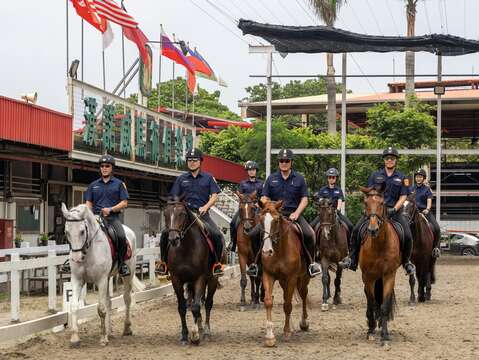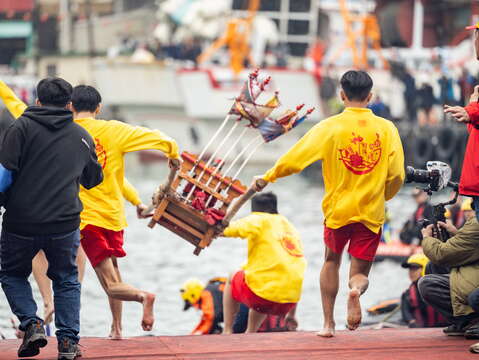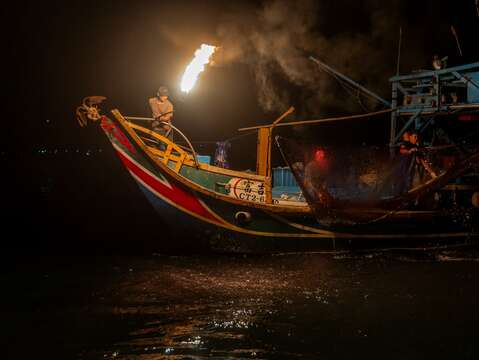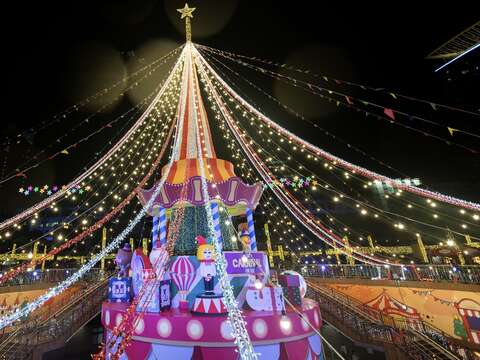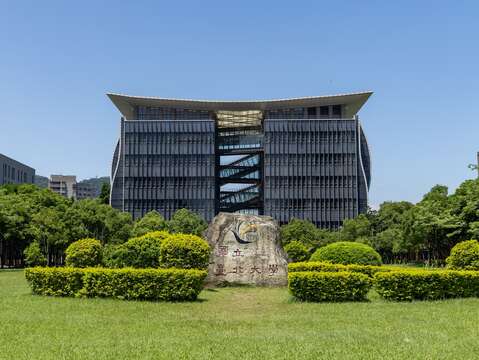Anchor point
Featured Articles
Trip Recommendation
The ways to have fun only known by locals
- New Taipei Mounted Police UnitThe majestic sight of horses isn't limited to ancient battlefields in films or televised sporting events. In New Taipei City, you can encounter them up close in public spaces! The New Taipei City Mounted Police Unit is the only mounted police unit in northern Taiwan and the largest in the nation. On weekday afternoons, they patrol the Xinban Special District, while on weekends they rotate between popular tourist destinations including Tamsui, Bali, Yingge, and Bitan. These dashing officers and their striking horses create the city's most distinctive scenery, not only maintaining public safety but also serving as a tourist attraction. Visit the New Taipei Mounted Police Unit's training center to get an inside look at the daily routines of both officers and horses, and witness equestrian excellence rarely seen in urban settings. Established in 2003, the New Taipei Mounted Police Unit was Taiwan's first mounted police force. With approximately 40 members operating as a "task force," officers maintain their regular duties and transform into mounted police when called to serve. To join the unit, members must complete 120 hours of specialized training and pass certification by the equestrian association! The New Taipei City Mounted Police Unit's training center is located at Hannover Equestrian Club, which spans an impressive 6,000 ping, making it the nation's largest equestrian facility. Training follows the English equestrian tradition, serving as a vital hub for both professional instruction and equestrian outreach. Horses are trusted partners for mounted officers on duty. Each horse has a name—Midnight Star, Sunny, and others—and like people, possesses a distinct personality. Some are spirited and playful, while others are calm and reserved. Officers must invest time to bond and develop rapport with their mounts. Training incorporates firecracker sounds, umbrellas, and various noises and obstacles to simulate real conditions in tourist areas, ensuring horses remain composed in any environment. Each deployment requires approximately 1.5 hours of preparation before officers can set out on their patrols. The mounted police's professionalism stems from rigorous training and proper equipment. Riding equipment includes saddles, girths, stirrups, spurs, saddle pads, and reins—all essential for mounted operations. On duty, officers also carry firearms and radios. The elevated vantage point from horseback enables them to monitor crowds effectively and maintain urban safety. Mounted police work extends beyond the saddle. Officers must not only ride but also care for their horses. At the club stables, feeding and grooming duties, along with attentive care of these trusted companions, form an integral part of the job. In the farrier's room, horseshoes mounted with openings facing upward symbolize good fortune—serving as the club's lucky charm! Want to meet the mounted police up close and capture memorable photos? The New Taipei Mounted Police Unit patrols the Xinban Special District from 3 PM to 5 PM on weekdays. On weekends and national holidays, they rotate among scenic locations including Tamsui Fisherman's Wharf, Bali Left Bank, Yingge Old Street, and Xindian Bitan, giving residents and visitors the chance to witness these officers in action and enjoy this unique urban spectacle. 👮🐎A reminder from the Mounted Police Unit: You may touch a horse's face or pat its neck. However, keep your hands away from its mouth and avoid walking behind the horse to ensure everyone's safety!
- Pingxi Sky Lantern Festival Brightens up Beautiful Sky in New Taipei CityIn the night of Lantern Festival, sky lanterns slowly fly upward, carrying people’s wishes into the night sky. The beautiful scene can be seen at the most representative festival in New Taipei City. Since 1999, New Taipei City government has held Sky Lantern Festival in Pingxi on Lantern Festival that falls on January 15 of the lunar calendar, and it is the grandest annual festival of the mountain town of Pingxi. For over twenty years, numerous tourists from home and abroad have attended the festival to light up sky lanterns, flying them into the night sky with their dreams and wishes. Multiple Origins of Sky Lanterns “Please help us!” During the Three-Kingdom Period, Zhuge Kongming (Zhuge Liang), the prime minister of Empire of Shu-Han, sent large paper lanterns up to the sky to deliver military messages by following the principle of rise of hot air when he and his soldiers were besieged by the enemy, and they eventually got out of the predicament. This the most well-known origin of the sky lantern, so it is also known as Kongming lantern. Others think the sky lantern gets the name of Kongming lantern because it shapes like the silk ribbon scarf of Kongming. Like Internet and other inventions, the sky lantern originated from military technology. The sky lantern has been considered the originator of the hot-air balloon, and the threshold of humans’ flying dream. The sky lantern first appeared in the battlefield in Europe when Mongolia went on an expedition to the west. Five hundred years later, the first hot-air balloon carrying passengers rose to the sky in Paris. Praying for Blessings at Lantern Festival After sky lanterns go about among people, the release of sky lanterns has become a folk activity for people to pray for blessings. Since ancient times, there has been the custom of releasing sky lanterns at Lantern Festival which is the birthday of Heavenly Lord Tian Guan, and the sky lantern is a medium for people to pray for blessings to the God. Pingxi District, New Taipei City is located at the upper reaches of Keelung River. In the beginning of the 19th century, immigrants from Fujian were harassed by bandits from time to time when they reclaimed Pingxi, and sky lanterns were used as tools to mark themselves safe. In the 1990s, Pingxi started the revival movement for sky lantern culture, attracting tourists to release sky lanterns in the mountain town. The activity has become the most famous one in Pingxi. Moreover, with the help of popular movies, Pingxi sky lanterns have become well-known around the world. Unique Climate and Terrain of Pingxi When it comes to sky lanterns, people think of Pingxi. However, why is Pingxi so closely related to sky lanterns? In accordance with current laws and regulations, Pingxi is the only area in Taiwan where sky lanterns can be released outside. Pingxi is one of the areas in Taiwan with the most rainy days, and it has a relative humidity of over 75% often. Damp environment prevents sky lanterns from wreaking havoc after they fall to the ground. Additionally, Pingxi is surrounded by mountains on four sides, and there is no airport nearby, which ensures that sky lanterns only fly in the mountainous area of Pingxi without disturbing flights, making Pingxi the best location to release sky lanterns. Pingxi District is a district in New Taipei City with least population. It was the settlement of the Ketagalan tribe. In the early 19th century, the Han people reclaimed Pingxi, and it became prosperous because of coal mining in the early 20th century. However, it became quiet again after mining ceased. The Pingxi Railway which was open to traffic in 1921 was once doomed to dismantle. Thanks to the endeavors of local people, the railway has turned into a sightseeing railway. The one-hundred-year Pingxi Railway passes by charming railway towns, such as Shifen, Pingxi and Jingtong, where you can find magnificent Shifen Waterfalls, and secluded stations rarely known to anyone. Light Pingxi tours are promoted every year during Sky Lantern Festival, and local tour guides would lead tourists to explore mining culture and railways, relishing the beauty of the mountain town. New Taipei City Pingxi Sky Lantern Festival New Taipei City government held the first Pingxi Sky Lantern Festival in 1999, and this year marks the 26th anniversary of the event. It is the most famous ceremony for Lantern Festival in northern Taiwan. The Sky Lantern Festival enjoys the fame with the beehive fireworks in Yanshui, Tainan as we always say “sky lanterns in the north, and beehive fireworks in the south.” The two festivals have repeatedly been selected the must-see festivals by travel websites. Two sessions of releasing sky lanterns are held each year at Pingxi Sky Lantern Festival, which are on the day of Lantern Festival and one weekend before the festival. Quiet a few sky lanterns are allowed to be released each time in each section. When over one hundred sky lanterns are released at the same time, the dreamlike scene brightens up the night sky of the mountain town of Pingxi. 👉Official website of 2024 Pingxi Sky Lantern Festival Sky Lantern Festival each year features the Chinese zodiac sign of that year. The main lantern that is up to 20 feet tall presents excellent sky lantern making craftsmanship. One can write on the sky lantern made with rice paper with a Chinese writing brush. After that, you put paper money inside the lantern as fuel to push it up to the sky. Sky Lantern Festival is the most important event in Pingxi District. Residents, public servants, schools and stores will all devote themselves to the grand occasion by participating in performances and planning fairs. To deal with a great number of tourists, New Taipei City government deploys police and firefighters to maintain the safety of participants, enabling them to enjoy the pleasure of releasing sky lanterns. Mountain Cleanup to Protect Environment Sky lanterns carrying blessings and wishes will eventually fall to the ground in the distance after they disappear from sight. To maintain the environment of Pingxi, New Taipei City government holds a mountain cleanup activity and cultural tour after Sky Lantern Festival every year to enable participants to help collect sky lanterns and listen to instructors tirelessly telling stories about Pingxi at the same time.
- “Get in the Sedan Chair!” “Let’s Go!” Yehliu Cultural Festival of Jumping into the Sea with GodsOne day in 1820, fishermen of Yehliu found a Fujian-style sailboat drifting alone on the open waters, so they boarded the sailboat to check, and found no one on it. However, they found a statue of Kai Zhang Sheng Wang and Chinese fir and limestone, building materials, in the cabin. After having a discussion, people resolved to welcome the god to their fishing village. They used building materials found on the boat to build a temple called Baoan Temple to bless fishermen in Yehliu a safe journey when they went fishing on the sea. Several decades later, a boat from Fujian struck a reef and sank. After the tragedy, Kai Zhang Sheng Wang entered the body of a spirit medium to indicate fishermen to offer sacrifices to pray for peace, not allowing the remains of victims to be brought to the fishing port. Kai Zhang Sheng Wang further indicated that He would go on an inspection tour around the port at Lantern Festival in person. Following the instructions of the God, young and strong residents in Yehliu carried the God’s sedan chair on January 15 of the lunar calendar, jumping into the cold sea water to expel ghosts and monsters at the port. This was the origin of jumping into the sea with gods in Yehliu. Come in Water and Go in Fire The tradition of jumping into the sea with gods in Yehliu has over one hundred years of history, and it is a unique activity at Lantern Festival at Taiwan’s Northern Coast. The tradition enjoys the fame with Sky Lantern Festival in Pingxi and beehive fireworks in Yanshui as they are all intangible cultural heritage. The four rituals of jumping into the sea with gods in Yehliu include “going on an inspection tour with gods on the sea,” “bringing back a whole cabin of catches,” “jumping into the sea with gods,” and “stepping on the bonfire with gods to expel evils and adversities.” Participating followers have to jump into the water with a god’s sedan chair first, and run toward the bonfire after they go ashore. Therefore, we say “come in the water, and go in the fire.” It is the most distinctive cultural festival in Wanli District. Jumping into the sea with gods is an annual occasion in Yehliu. Residents and fishermen in Yehliu support the event by donating money and contributing their labor to plan it. It is an important activity that enables local people to work together as a team. The event of jumping into the sea with gods starts early in the morning, and followers and sacrificial service chiefs carry out the blessing ceremony successively in Baoan Temple. In front of the temple, you can see the spectacular performances of the lion dance of Yehliu Elementary School, beiguan music club, and god’s generals. It is difficult to take your eyes off the performances, and you can hear the sounds of camera shutters one after another as well. The temple workers carry the eight gods’ sedan chairs to the front of Baoan Temple. After they carefully place gods’ statues in the sedan chairs, they hang firecrackers on the sedan chairs. Strong and brave men carrying the sedan chairs move forward while firecrackers are being set off. For a moment, the sounds of firecrackers resound across the sky, going through the cloudy and rainy sky to the Heavenly Palace. Going on an Inspection Tour with Gods on Sea The lead boat sets sail with people’s blessings, kicking off the event of going on an inspection tour with gods on the sea. Over ten fishing boats follow the lead boat in order and dash out Yehliu Fishing Port amid the loud noise of firecrackers. During the one hour of the inspection tour, all fishing boats circle around Yehliu Fishing Port three times to pray for plentiful catches and safety. Bringing back a Full Cabin of Catches After an inspection tour on the sea, fishermen will open their cabin and crane up a full load of catches to the truck before they return to Baoan Temple. This means that fishermen will get a full load of catches on their each voyage this year. Next, the city mayor will host a charity auction for catches, where competitive bidding can be seen at the scene. Jumping into the Sea with Gods The highly anticipated event of “Jumping into the Sea with Gods” starts in front of Baoan Temple as people shout “get into the sedan chair” and “let’s go” loudly. Strong and brave men in Yehliu carry the eight gods’ sedan chairs for Kai Zhang Sheng Wang, Mazu, General Zhou Cang, the Lord of Land and so on, and they brave the cold and dash into the fishing port amid the loud cheers of people. The scene is exactly the same as the one when Kai Zhang Sheng Wang went on an inspection tour at the fishing port over one hundred years ago. The ceremony is held to expel ghosts and spirits, praying for favorable weather and safety. In recent years, the event has changed with the times: people are welcome to join the activity of jumping into the sea with gods, and a design competition is held. After gods’ sedan chairs arrive at the fishing port, 100 people are welcome to participate in the event of jumping into the sea. The year 2024 is the year of the dragon, so quite a few participants wear clothing with the style of the dragon to celebrate the year of the dragon and pray for safety in the coming year. Stepping on Bonfire with Gods to Expel Evils and Adversities After strong and brave men carrying gods’ sedan chairs jump into the port, they have to swim across Yehliu Port with the sedan chairs. After they come ashore, they are ready to step on the bonfire. When it is time, the shouts of “get into the sedan chair” and “let’s go” echo throughout Yehliu, and strong and brave men carry gods’ sedan chairs and step on the bonfire that has been sprinkled with salt and rice barefooted to purify calamities on their bodies. After doing this for three rounds, they complete the ritual of “coming in the water, and going in the fire.” Being led by the beiguan music club, gods make a pilgrimage procession around the fishing port to protect Yehliu. The cultural festival of jumping into the sea with gods originated from a mysterious unmanned boat drifting on the sea over one hundred years ago. After Kai Zhang Sheng Wang was brought ashore by local fishermen, He entered the body of a spirit medium to go on an inspection tour at the port to protect the safety of Yehliu Fishing Port. Residents in Yehliu, in return, pass down the tradition. The event of jumping into the sea with gods is not only a special activity at Lantern Festival, but also a shared memory of residents of different generations in Yehliu.
- The Fluorescent at Night on the Northern Coast - Jinshan Sulfuric Fire FishingAt night, near the coast of Jinshan District, the only on the dark sea surface is the 4000-watt white fish-attracting lights of a neritic squid-catching boat in the distance, the sound of waves, and the sporadic traffic on Provincial Highway 2. Suddenly, a "boom!" sounded, and the flashing torches illuminated the silent sea surface, and the phototaxis small fishes jumped out of the sea one after another. This unique scenery limited to summer comes from the traditional fishing method unique to Jinshan Huanggang Fishing Harbor - "Jinshan sulfuric fire fishing," the most dazzling conventional fishing method in Taiwan. The sulfuric fire fishing boat is also commonly known locally as the "Hia-A-Tsun." Fishing boats set sail at night, and the captain stands at the ship's bow with a torch to attract phototactic fish species, such as pilchard, to jump out of the water, then catches them with a skimming net. It has been a traditional fishing method in Jinshan for a hundred years and was registered as a cultural asset of New Taipei City in 2015. During its heyday, more than 40 sulfur fire fishing boats were operating in the waters off the northern coast. However, in 2016, the T.S. Lines cargo ship ran aground in Shimen, causing an ecological disaster on the north coast due to the oil spill. The June 2017 flood caused seawater desalination in Jinshan, severely damaging the area's marine ecology for the second time and causing schools of pilchard to leave Jinshan. At one point, only one remaining ship, the Fuji 268, was still in operation. Fortunately, after several years of persistence, some mud carp have returned to the Jinshan coast in the past two years. Also, fishers have transformed the sulfuric fire fishing boat into a tourist experience activity. During the Sulfuric Fire Fishing season, which lasts from May to September every year, they combine fishing village tours with sea fishing to preserve the beauty of traditional fishing methods. The sulfuric fire fishing boat uses a flat-bottomed and flat-headed boat. It has a low speed but has the characteristics of fast turning and high maneuverability. 4-8 people operate the sulfuric fire fishing boat, including the captain and the fire crews. They use a fish finder on the bow to search for fish. The fire crews then use searchlights to identify the fish species. After confirmation, they use a torch to attract the light, attracting pilchard, Japanese anchovy, and other fish to jump out of the water. Also called Tainan sardine, pilchard is used as fish bait or grouper feed after processing. When the fishing conditions are good, a sulfuric fire fishing boat can catch more than 800 baskets of pilchard. The earliest sulfuric fire fishing boat used bamboo torches. After introducing calcium carbide during Japan's rule, fishers changed the ignition system to calcium carbide. Fishers poured water into the calcium carbide barrel to produce acetylene gas and through the filter cylinder to ignite the torch. The ignition produced a "boom" sound, which is the origin of the name of the sulfuric fire fishing boat today. Take a yacht out of Huanggang Fishing Port and enjoy one of Jinshan's eight scenic spots, "Bamboo Peak Mist," while tasting rice noodles with neritic squid. From the sea, enjoy the beautiful coastline of Jinshan and watch the dazzling Jinshan sulfuric fire fishing boat up close after nightfall. The yacht sails out of Huanggang Fishing Port, and what comes into view is the Jinshan Cape deep into the sea and the most famous landmark of Jinshan - the Twin Candlestick Islets. Besides, overlook the Yehliu Scenic Area and enjoy the scenery of the Jinshan coastline. While waiting for the sulfuric fire fishing boat, pick up a fishing rod and experience sea fishing fun. In the waters between Tiaoshi Coast and Yehliu, the sulfuric fire fishing boat used fish finders and searchlights for schools of pilchard at night. The yacht began to turn off the lights. After turning off the lights so as not to affect the sulfuric fire fishing boat's search for schools of fish, the yachts followed the Fuji 268 sulfuric fire fishing boat, everyone in the yacht holding their breath and waiting for the moment when the school of fish jumped out of the water. "Bang!" the gorgeous torches ignited on the sea, illuminating the dark sea of Jinshan. This unique view of the world is undoubtedly a beautiful visual feast. "Yes, here comes fish!" Stimulated by the flames, the school of pilchard jumped out of the water, flashing like fireflies on the sea. The crew members skillfully caught the pilchard with the skimming net, and the passengers on the yacht celebrated with thunderous applause. The fire crew waved his hand handsomely to greet the crowd. The flashing torch in his hand is not only a tool for fishing but also carries a sense of mission to continue the tradition and pass on the unique traditional fishing method of Jinshan.

